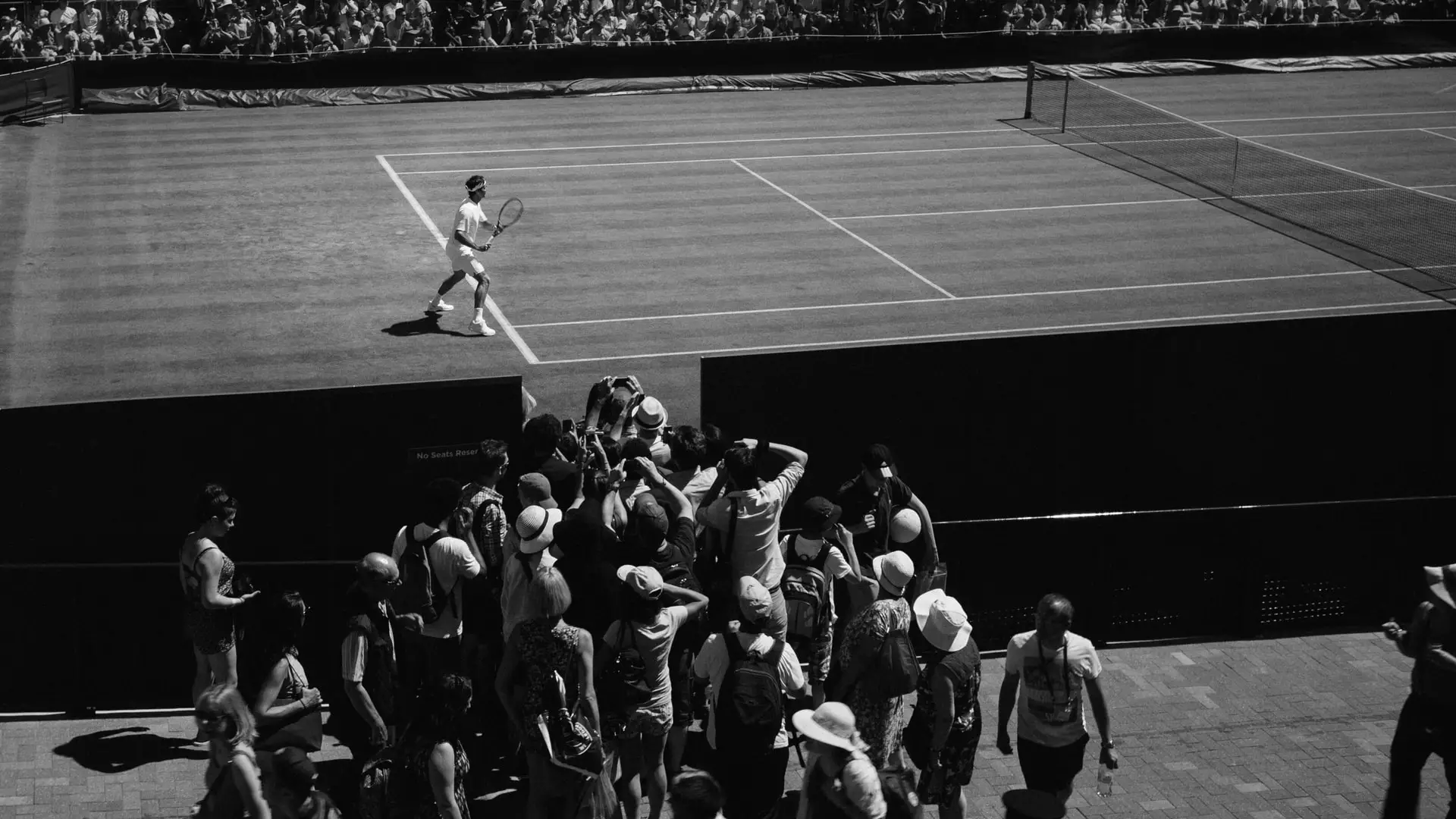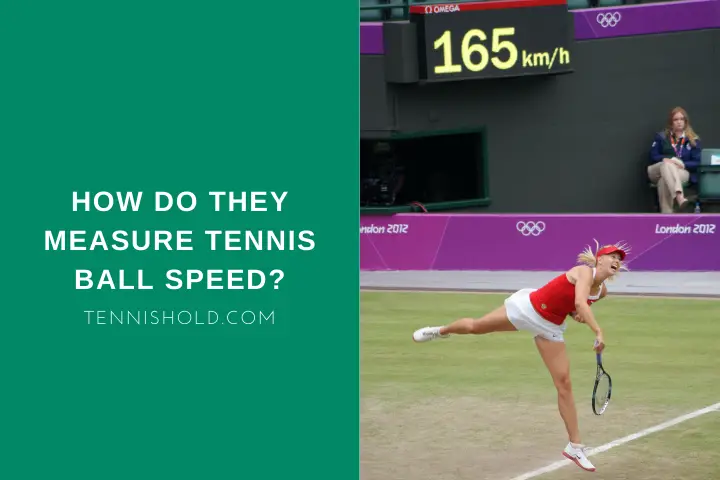Something I like to do when watching tennis matches on TV is to observe the speed clock at the side of the court.
Most courts used in professional matches will have a one-speed clock at each end.
It’s interesting to see the variation in speed, especially between the first and second serve.
It can be even more fascinating to see the variation in serve speed as the match progresses. For example, you might notice a player getting tired and seeing their average speed drop.
Almost everyone who watches tennis on TV will have noticed the speed clock, but there is an unanswered question.
How is the speed of the ball measured?
A speed gun will send out waves of radar pulses, some of which bounce off the tennis ball and back to the gun. The time between the pulses is measured. The ball is moving, so the frequency of pulses will be different. The frequency can then be translated into a unit of speed.
The process used for measuring the speed in tennis is the same in many other sports. An example is someone bowling in baseball.
In this article, I will cover:
- At what stage the ball speed is measured
- How a tennis speedometer functions
- Where the speed radar can be found
Read on if you’d like to learn more about speed guns in tennis!
At What Point The Speed Of The Ball Is Measured?
![]()
When a player serves, it takes a few seconds before the other player contacts the ball. After the server has hit the ball, it will immediately start slowing down.
This means the speed measured when the ball lands on the opposite side of the court will be slower.
Why Is The Speed Measured At The Server?
At what point in the ball’s flight is the speed measured?
The serve speed is measured immediately after the ball has come off the racket. By measuring the speed at this stage, it reads the ball at its fastest.
Other shots within the rally are measured in the same way. So, for example, if it pops up on the screens saying the forehand winner was 80 mph, the ball traveled at that speed just after it came off the racket.
If the ball had been measured at the end of the flight, it would have slowed down substantially. This is due to friction as it hits the ground and the drag.
Drag is the aerodynamic force that resists the motion of the tennis ball while it travels through the air.
When the ball reaches the opponent following the serve, it can lose as much as half its speed.
There are several reasons why the speed is measured immediately after the server contacts the ball. Firstly, it gives a clear reference point to compare different serves.
John Isner holds the (ATP recognized) record for the fastest serve at 157.2 mph. Ivo Karlovic has the second highest at 156 mph.
Using that same reference point guarantees a fair measurement for comparing speed records.
Another reason is marketing and engaging the public. That 157.2 mph serve of John Isner’s may have reduced to just 120 mph by the time it reaches the returner.
120 mph is still fast, but it is not as impressive as 157.2 mph.
When commentators talk about higher numbers, it sparks more interest from people.
From a marketing perspective, it has the same effect.
Isner’s racket sponsors could use this large figure to market the racket model.
How Does A Tennis Speedometer Work?
https://cz.depositphotos.com/stock-photos/speedometer.html?filter=all&qview=4614244
The speedometers used for measuring the speed of tennis balls work similarly to police speed guns.
The difference is that one measures a moving car’s speed and the other a tennis ball in flight.
The speed gun will first emit a series of radar pulses. Some pulses that hit the tennis ball will bounce back at the gun.
Once the time between the radar pulses is known, the time between pulses received is measured and compared.
Due to the ball moving further away from the speed gun, the distance and the time between pulses will also increase.
If the ball moves toward the speed gun, the distance will gradually decrease; thus, the time between pulses will be less.
How Is The Speed Calculated?
The speed the pulses travel is the same as the speed of light. Therefore, as the speed of the vibrations is unchanged, the gun can calculate the frequency change.
Let’s assume that the gun is measuring the speed of the serve. If there is more time between the frequencies, it suggests that the ball has been hit faster.
This is because it has gone from point A to B quicker.
The speed of the ball is determined by the difference in the sent and received radar pulses.
Once the speedometer has calculated the difference between the pulses, it will convert it into a unit of measurement. In tennis, this will be either miles or kilometers per hour.
The vision of the speed gun is wide and includes more than just the ball. You may now wonder how it knows to focus on the tennis ball.
It filters out unnecessary movements, such as people moving or balls rolling on the ground.
It achieves this by focusing only on pulse frequencies above a certain level. As a result, there is nothing in the view of the gun that will travel as fast as the tennis ball being hit.
The operators can set the gun to a high minimum frequency, knowing that it will only pick up the ball being hit.
This change in frequency that I refer to is known as the Doppler shift.
Where Is The Speed Radar Located?

A common misconception is that the speed radar on a tennis court is located on or by the net. The idea is that the gun measures the speed of the ball as it travels over the net.
This comes back to the problem I mentioned earlier on.
As soon as the ball comes off the racket’s strings, it begins to decrease in speed.
Thus, by the time it has come over the net, it will have lost much of its speed, and the pace recorded will be less.
On the pro tour, the speed radar is located behind the two players at each end of the court.
You may have noticed a wide gap in the backdrop behind the players. This is because you will usually see a lot of cameras and photographers stationed here.
You will also find the speed radar in this area behind the players.
Where Is Radar Aimed?
The speed radars will be aimed toward the players and the ball, but the angle is not very important.
The reason for this is that the gun focuses on the ball. It does this by setting a high minimum frequency. This means it will only measure fast-moving objects.
Some of the retail radars available to the general public are designed to be mounted on the back net of the court.
Sometimes they will come with a tripod and are designed to be placed beside the net.
These radars are obviously not as accurate as the ones used on the pro tour.
You can buy cheaper radar guns for private use such as this pocket radar on Amazon.
Final Words
The technical process of measuring speed may be complex, but I hope it is more understandable for you now.
I’ve only used a professional speed gun twice. They had one at the ATP Tour Finals fan zone in London.
My experience with the speed guns designed for private use is mixed. They are good fun, but I’m not sure how accurate they are.
What do you think? Is around $200 worth it for a personal speed gun?

